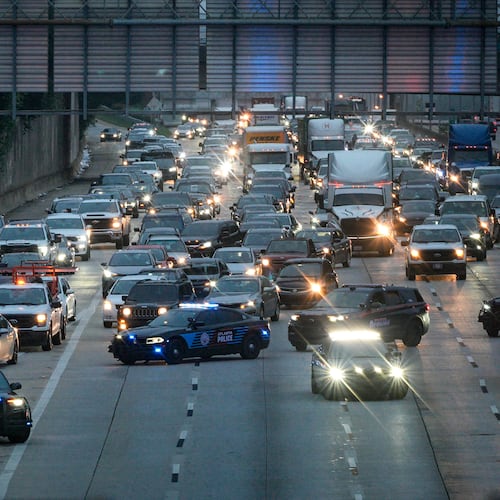Let’s set the tone: You, the readers, are what make this weekly column worthy of both my time and each other’s. Your knowledge and observations push me harder and give deeper context to issues on our commutes. And no one is a greater expert on their own route than themself. The WSB Traffic Team is a group of experts on the entire Metro Atlanta commute and transportation engineers are geniuses (most of the time) in traffic design and flow behavior. But you have an advanced degree in your own drive.
With that said, several readers sent in some interesting questions and comments that deserve daylight and attention. As always, comments are edited for clarity and length.
Many people don’t realize that their tail lights don’t come on with just their driving lights. I’ve seen many incidents of people with auto-headlights thinking that turning on the headlights is not necessary, because they have driving lights. That is not the case, as the people in back of them can’t see them because they have no tail lights on.
-Orlando E.
If I were an engineer, I would come up [with this feature] for autos: lights that come on automatically when the windshield wipers are activated. Alas, I’m a retired editor and not an engineer.
-Susan M.
Many people emailed in response to the recent column on driving with hazard lights in the rain and to others on similar subjects. Orlando, Susan, and several others all sang the same tune: Tail lights do not turn on when driving lights are on. In daylight, drivers need to override their auto-lights and turn on the headlights in the rain, so that both the front and rear lights are on.
And Susan has a brilliant idea with lights being activated with wipers. If cars can self-drive, they certainly could have a wider spectrum of other automatic features.
I was in Downtown Atlanta yesterday and I noticed that 3rd Street, which was one-way, is now two-way. 4th Street, which I think was also one-way, is also now two-way, and maybe some of the other numbered streets have been converted as well. I would have thought these changes might have gotten some press and might have even been covered in your column. Unless I missed it, I haven’t seen anything on this.
-Richard S.
First, on the coverage - changes on smaller streets like that are not necessarily headline-worthy, but the modifications matter to those that use them. Thanks to Richard, we’re reporting it now.
Atlanta DOT commissioner Josh Rowan (not to be confused with GDOT commissioner Russell McMurry) has insight on the conversions.
Essentially, he told The Atlanta Journal-Constitution and WSB, one-way streets came from a 1970s plan to move traffic more quickly on the grid pattern that Atlanta and most urban areas use. However, Rowan said, that “one-way system” is less safe, mainly because of wrong-way drivers and cars traveling at higher speeds on wider corridors. So Atlanta’s transportation plan calls for numerous conversions of one-ways to two-ways.
Great question, Richard, and thanks to Rowan for the assist. I had to bother him again for another question on pothole markings.
I ride my bicycle through several neighborhoods in Atlanta and have encountered numerous potholes outlined in white paint. Some holes are highlighted by solid lines, others are dashed. My question is who is doing this, and is there a plan to fix them once highlighted? I’m not certain if this is a city project or neighbors warning others of potential danger to their vehicles. I’d appreciate any insight you can offer.
-Marshall B.
Great question, Marshall.
While neighbors possibly are flagging road problems, Rowan says there is a method to the marking madness.
“Our inspectors will mark areas that need to be repaired. You will see the white paint for potholes, manhole adjustments, utility cuts, etc.,” Rowan said. So different markings signify different types of work. And, “When we get a 311 request, we will have an inspector on site within 72 hours to assess the situation.” Drivers should take note and dial 3-1-1 to report utility or road issues in the City of Atlanta.
I have driven stretches of South Fulton Parkway and on I-20 in East Georgia and have noticed these thin strips of cement that divide the medians. What are these? It looks like a sidewalk to nowhere!
-Jill N.
I have never noticed this myself and certainly had no idea what these paved strips are. However, GDOT spokesperson Natalie Dale answered this for us almost as fast as Jorge Soler homered in Game One of the World Series last Tuesday.
Dale said that the concrete in the medians sets the footings for those cable-barriers that the state installs for safety. These are most common on freeways or highways where there is no median wall and vehicles can easily cross the center-grass and hit oncoming ones head-on, at high-speed. The cable-barriers greatly decrease this risk.
Cable-barriers are on the way to these highway and freeway stretches. Dale’s gotten this question often and had that snappy answer, further justifying the “Nat Queen Cone” moniker I have given her.
We have gotten numerous questions about road fixes over the last few weeks and I usually forward those to the correct parties and try to respond individually when I hear back. Please reach out anytime you have comments, questions, complaints, or problems and the WSB Traffic Team and I will try and help. Thanks for writing-in and reading, truly.
Doug Turnbull, the PM drive Skycopter anchor for Triple Team Traffic on 95.5 WSB, is the Gridlock Guy. He also hosts a traffic podcast with Smilin’ Mark McKay on wsbradio.com. Contact him at Doug.Turnbull@cmg.com.
About the Author
The Latest
Featured

